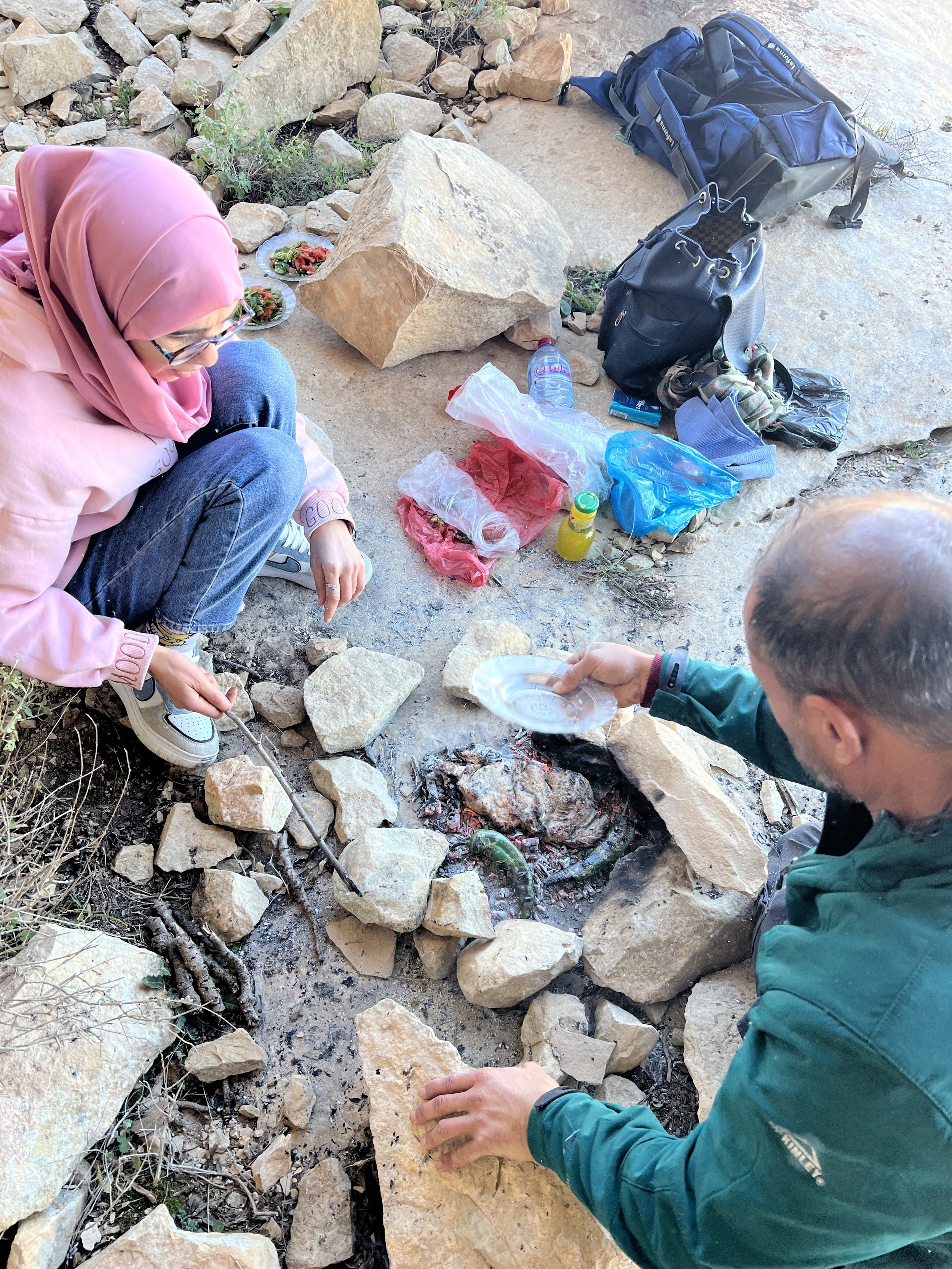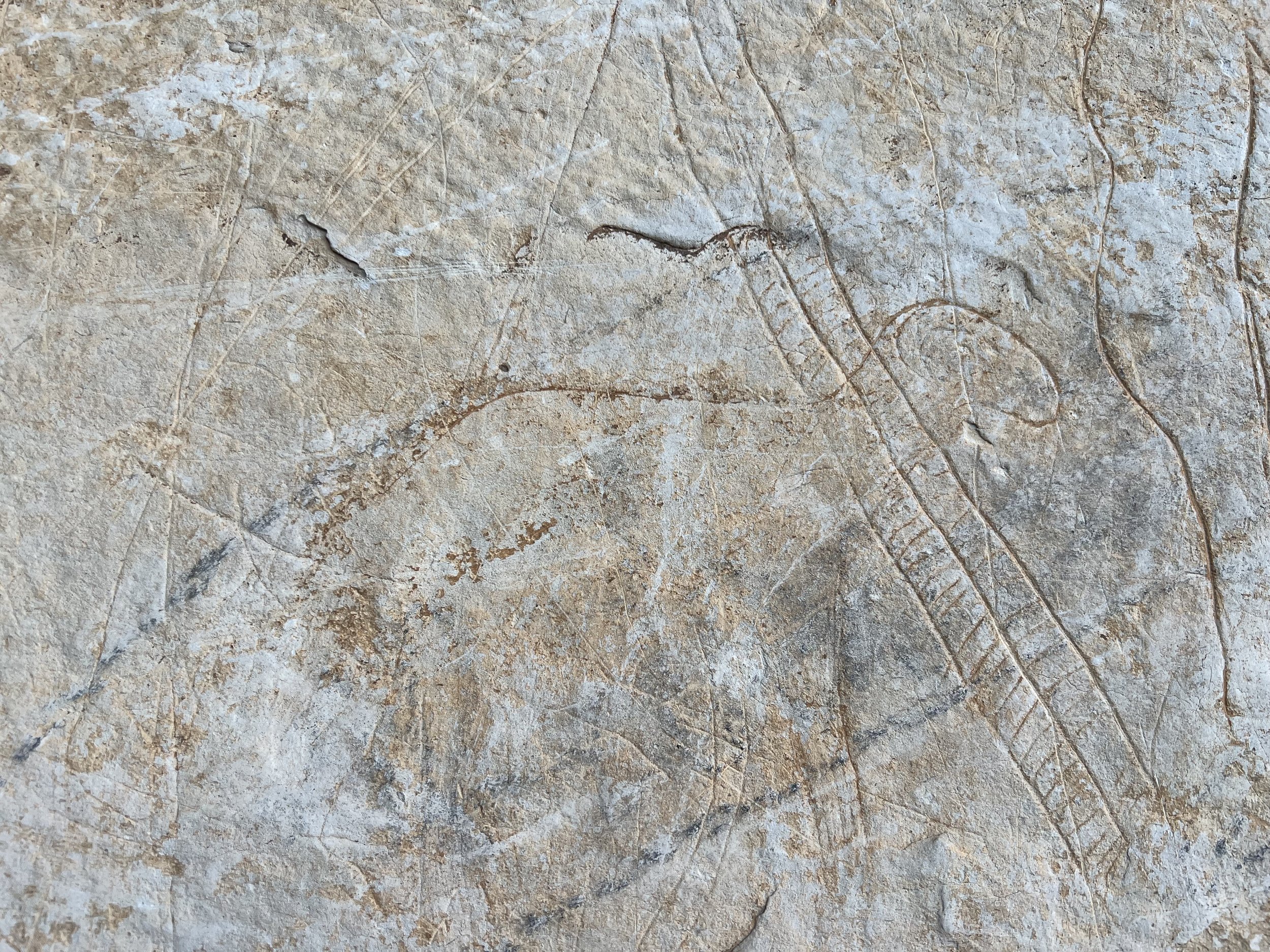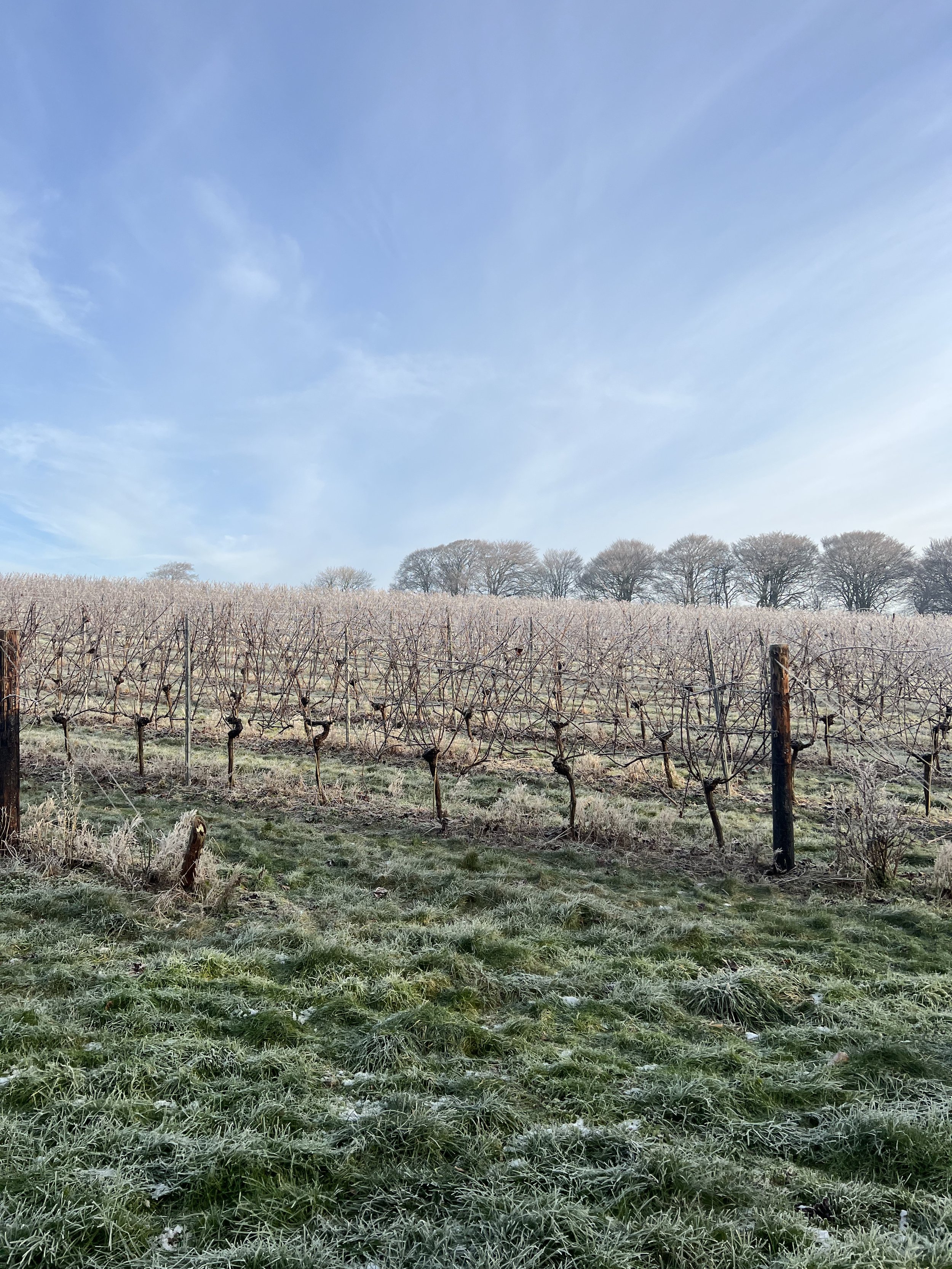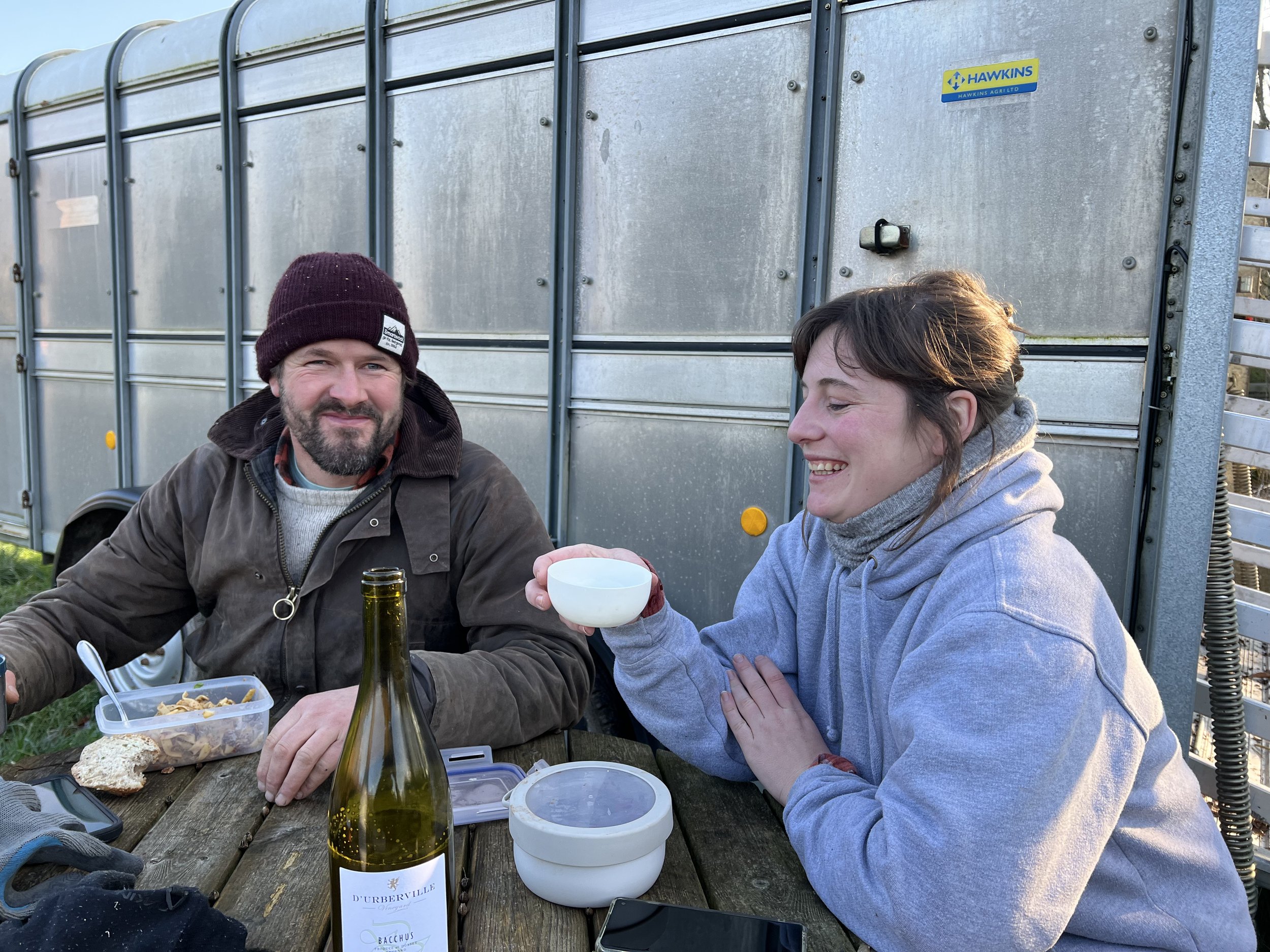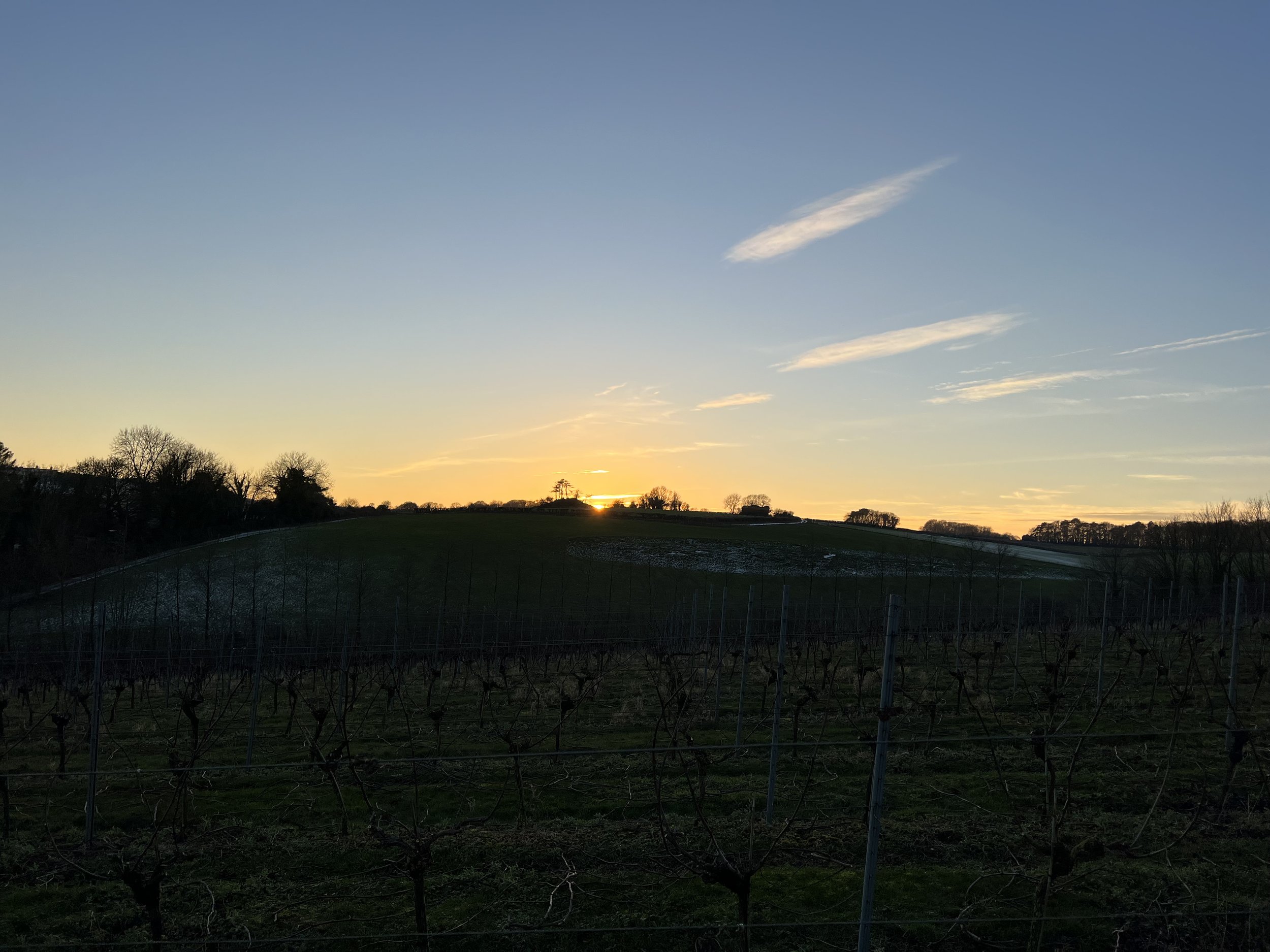In the rocks
Semi and Abir fanning the flames of our lunch fire
I had lunch yesterday in a small overhanging rock shelter called R’mada in the Djebel Ousselat area of Tunisia. Our guide Semi, had collected dried wood and built a small fire that he let burn down into embers upon which we roasted tomatoes, green peppers and a butterflied turkey breast. We ate this with bread and local olive oil just metres away from the Neolithic rock carvings we had hiked to see.
The carvings in the R’mada cave are the oldest in Tunisia, dated to around 5500 BC; they’re wild and varied, from a lovingly naturalistic portrait of a sheep to a wild ram’s head and fleece cloaked figure overlaid by a ram itself, seemingly engraved in some mystic fever dream.
Paleolithic engraving of a sheep, R’Mada, Djebel Ousselat
The wilder more mystic image of a man presumed to be wearing the head and fleece of a ram, engraved across him is another ram.
It occurred to me as we sat over lunch that this spot had likely seen lunches of a very similar nature for at least seven and a half thousand years. Making it both a humbling and moving moment.
The age of the engravings, gravure rupestris in French (recognising the Latin root of in the rocks rather than the Anglophone term Paleolithic which takes instead from the Greek lithos) places them at the end of an era known as the African humid period, indeed other local art from the era shows hippopotami, giraffes and rhino, all animals that are now native to savanna and other wetter climes. It’s telling how the landscape has suffered not only from there realignment of the earth’s axial tilt but more brutally from human mismanagement.
The nearby El Jem is on the site of Roman city Thysdrus which grew fat on enormous grain and olive oil revenues. The surrounding landscape there, like everywhere else nearby, is now barren but for scrub and olive trees. Sheep and goat herds roam the hills eating what remains.
Furthermore it was hard not to think on the parallels between us sitting in this once lush landscape carefully nurturing the flames of our lunch fire with the wild fires that were at that moment turning the once paradise of Los Angeles into a deadly inferno after another hottest year on record.
It wasn’t just the flames that seemed intertwined. Our own lunch choices could have been designed to highlight the interconnected warp and weft of this historical tapestry in which I sat. Tomatoes, peppers and turkey, all transplants from the Americas, both North and South.
Rupestris; ‘from the rocks’, also the name of another notable American transplant. Vitis Rupestris, one of the key root stocks that were brought over to rescue European viticulture from their fellow trans-Atlantic passenger the Pylloxera louse.
The root stocks that, along with the climate change that is laying waste to the West coast of America, are making a wine industry not only possible but thrilling to be part of. The wines of which I’ll be taking with me back to Africa in a week or so as I callously disregard any meaningful attempt at mitigating my Carbon footprint in an attempt to learn better how to work with grape varieties who’s potential is blossoming in the home just as so many others are losing theirs.
Vinegar interrupted, or why we ought not hate on oak.
Wine, at its most basic, is but vinegar interrupted. The sugar in grapes will ferment and that wine will spoil with acetic acid bacteria turning it to vinegar. The role of the winemaker in all this is to stay the inevitable. To nudge the broiling ferment into the direction of wine. In this endeavor they find themselves in a continuing dialogue with oxygen, both as an ally in terms of its role in mediating the development of phenolic structure (one of the many reasons why the brutally tannic wines of young Bordeaux are mostly a thing of the past) but also as a most pernicious of foes. It’s oxygen exposure (along with shitty hygiene) which is most likely to lead your lovingly grown grapes down the path to vinegary perdition.
Our now non-vinegary, deliciously wine flavoured product also has another major flaw. It’s a liquid and as such will need to be contained within something non or mostly non porous.
A messy tangle of barrels in an unused part of a winery in Serbia.
It’s here that we first encounter oak.
Allegedly it was the Gauls who first introduced the Romans to the art of tonnellerie (barrel making), diverting the more northerly reaches of the empire away from the ceramic focused trade in amphora and wines fermented in earthborn and earthbound qvevri.
What we think of as new oak flavours are a very modern development, for most of its time spent nurturing young wine, oak was a neutral partner. Witness the majesty of walking through a classic Barolo cellar, the boulevards of botti standing sentinel over their youthful charge. The wine contained within emerges snarling and potent.
Botti chez Mascarello
We don’t really see new oak in the winemaking dialogue until the post war era. The great enologist of the age, Emile Peynaud was concerned with improving the cellar hygiene of the Bordeaux estates that he worked with. Much of this came down to the replacing of old and problematic barrels in the cellars. The influx of new oak barrels changed the wines that were being made. This wasn’t uncontroversial, indeed the dialogue at the time rather closely matched the more recent barriques in Barolo fisticuffs that dominated the Piedmont through the late 90s.
Around the same sort of time the Californians and Australians were unravelling the secrets of Burgundian Chardonnay making. Malolactic fermentation to soften the wine’s acidity and add an appealing butteryness, a touch of extra toast to the pristine new oak barrels to add spice to the extracted tannic structure.
And just like that the world turned upside down. *
For as long as the Europeans had been making wine they had sought ripeness; power and puissance were the watch words, the greatest vintages were those where long hot summers had imbued the vintage with precious extra degrees of alcohol. Texts spoke longingly of les galets, the pudding stones of Chateauneuf, and how they stored the sun’s heat to reflect it in the night. However, now, these upstart regions found that ripeness almost too easy to come by, there were no bad vintages, only variations on excellence.
It’s here that oaken vessels start to get their bad name. German post war industrial developments had gifted the world temperature controlled stainless steel tanks (along with sterile filtration) and as such the necessity of large oaken vats was no more. Winemakers started to look to oak for its other properties. Shorn of the need to split logs into wildly wasteful staves as part of eye wateringly expensive oak barrels, winemakers started to experiment with oak barrel alternatives. Toasted staves to dip into your steel tank of Chardonnay, large evenly toasted chips of fine Troncais oak to add texture and precisely calibrated tannins to your premium Cabernet. While none of these uses are inherently wrong, they conspired to rob the character of oak of its mystique. It became the background flavour to any number of run of the mill wines that now started to taste tired and ubiquitous.
Furthermore, the use of oak barrel alternatives failed to allow the more subtle aspects of elevage in barrel or botti to come into play. The fine pores of the wood store minute amounts of oxygen which are transferred into the wine as it ages, this is where the changes to texture we alluded to earlier take place. This is how the sharp angularity of steel tank Sauvignon gets rounded, the polyphenols polymerising to create something akin to sensuality of mouthfeel. How the grippiest of Malbec tannins get turned into the texure of rich plush pate sable.
As with all things wine related, there are rarely any solidities or absolute definites. Visiting any wine region will yield cellars full of barrels; and winemakers with barrel programs will always have a portion of new barrels brought into the rotation as older barrels cease to be usable or no longer behave exactly as they would like.
In many modern cellars we see various ceramic vessels added to the mix imparting different micro-oxygenation properties and giving winemakers some extra textures and flavours to add to their blending palate. For those with an historical bent there is a pleasing circularity to seeing the descendents of the Gauls turn back to the children of the eastern Mediterranean’s ceramic vessels, and for those that love good wine there’s much to celebrate we’re now in a blessed age where great winemakers across the world are using oak barrels as part of their elevage repertoire to make brilliant wines the variety and quantity of which we’re never seen.
* “Immigrants, we get the job done“ is particularly apt when considering those of a Croatian descent named Michael and the making of world beating, Burgundy baiting Chardonnays. The 1973 Chateau Montelena made by Mike Grgich won the 1976 Judgement of Paris and he went on to be one of the pre-eminent winemakers of his generation.
Michael Brajkovic has been similarly genre defining with his tenure at his families Kumeu River. In particular he’s been the person most closely associated with the modern understanding of reduction in Chardonnays and how to manipulate it with wild yeast ferments and levels of suspended particulates in must (turbidity); something you can barely escape from winemakers discussing nowadays.
Pruning as a metaphor
I spent much of last week in Dorset. I was reminding myself of how and why we prune vines.
A uniquely thoughtful practice that I found surprisingly soothing.
Sober contemplation, a paring back of previous year’s growth and excess to leave the vine ready to return to fruitfulness in the new year; but more than that, there’s an element of benevolent guidance, if done properly you’re helping the vine return as a better version of itself, choosing the best canes, removing those that didn’t thrive or those that prospered in the wrong places. It’s a practice that’s heavy with metaphor. Especially so, if one is also in a period of change.
I hadn’t remembered pruning being quite as mindful as I found it. Each vine presents as part puzzle, part history, part possibility. You take a moment to look at where it has grown, to look for the parts that want to be left but trimmed, and then neatly remove the growth that needs to be removed. It’s as simple as that.
Add in the somewhat solitary nature of pruning and it turns out it’s a fabulous time for ordering thoughts and ideas.
To add some context; I was in Dorset starting the second phase of the Some Mondays wine project. Having successfully managed to get two wines into barrel last year on the back of minimal planning (mostly conducted over a couple of long lunches), I had found myself in a position where my principles and interests started to make themselves heard over the daily clamour and noise of my brain.
I had asked myself the question of what I wanted to do with a wine making project; was it a way to play with different styles of wine that I like, was it a way to ask slightly subtler questions about how best to express what grapes grown in vineyards I have access to can present in a glass.
It didn’t take me long to conclude that, just as most of the wines I love come from winemakers with real connections to the vineyards from which their grapes come, I too needed to have a meaningful connection with mine.
Obviously Duncan McNeil wasn’t going to take me on as a partner in his brilliant work in Essex. However, Colin in Dorset would be only too willing to let me come and lend a hand at D’Urberville; and so it was that I was at Langham last week, where in addition to getting my first taste of my rosé de saignee base wines from barrel, I was also getting a crash course refresher in pruning.
Fast forward to the start of this week and I was helping Rob and Olivia from Castlewood and their team of Bulgarian and Albanian labourers prune D’Urberville. I can’t express quite how good it felt leaving on Tuesday. The pruning and pulling out had been finished, but more than that, I had spent two long days getting to know the angle of the hill and the feeling of the sun on its southerly exposure.
I’m hoping it’s just the start of what will become a meaningful relationship with this little spot of Dorset.
Wine is broken
The world of wine is broken.
An inflammatory statement, but one that I think has some basis in truth. Despite there being some ten thousand different grape varieties on the planet, we rarely see more than thirty being planted. This has led to the creation of genetic monocultures across the globe. As students, we’ve learnt to ask exactly which clones of the same varieties are being planted: 667, 777, 778, - the exact same genetic material transported from Nuits Saint Georges to plots of land as far as nurseries can propagate.
It’s no surprise that with such an abundance of opportunity pests and diseases have learnt to love Vitis Vinifera; from the dawning of the international era, the history of viticulture has seen a litany of reactions to major pest and disease waves.
Downy and Powdery, the mildews came first - harbingers of troubles to come. Phylloxera followed, destroying agricultural societies and tearing apart the structure of rural European economies. Our response - the grafting of European varieties to American rootstocks, was genius. A blunt barber surgeon approach to creating hybrid vigour.
Pocket knives, tape and wax; bench grafting gifted viticulture the glorious chimera that is the modern vine. One that is sustained by a diet of sprays and treatments, a sickly patient whose progeny have colonised the world. A world made simple by the advent of mass media and advertising that makes us all desire the same things.
It’s no surprise that we dream in Burgundian and Bordelais archetypes. Post the second world war, the US was ascendent and its GIs had all fallen in love with France; the nascent mass media grew up with a paradigm luminated by the city of light. France was culture and her wines were the greatest. We copied the French and devoted countless hours to reverse engineering her greatest treasures.
An entire industry was born: devoted to trying to emulate the agricultural products of what is really just a few hundred hectares of vines.
Lafite, Latour, Petrus, La Montrachet, Romanee-Conti and Hermitage. Placed side by side these vineyards would be walkable in an hour. Their spiritual children, however, span the globe and utterly dominate the wine world’s internal dialogue.
This, I believe, is a problem.
Wine needs to be desirable; its nature is as a pleasure, something sought after, something shared in good spirits.
It is up to us to change the narrative, to reconfigure the messaging that creates markets. We already have a beautiful upswelling of interest in organic and regenerative viticulture, something that dovetails wonderfully with a generational interest in undoing previous generations' damage to the world.
Sadly, I don’t think this is enough.
I think we need to create new archetypes - newly desirable things that can be made from less disease prone plants grown in a less monocultural fashion.
We need to be adaptable.
I’ve taken my inspiration from lichen; they’re a symbiotic relationship between funghi and bacteria that both appear in the most barren places and yet are also a signifier for land that’s bereft of pollutants.
I want to create a wine that exists free of the strictures of cultural history; a wine that can celebrate the new world of hybrid grape varieties - varieties that have been bred to co-exist with mildew pressures. I want to create a demand for less chemical dependent viticulture, and I want to make it fun.
Some Mondays grew out of the barren wasteland of Mondays for hospitality staff.
Lichen by Some Mondays is my vision to create wines that people want to drink and that can be made with less stress on the planet.
I want to see rooms of people laughing over bottles made from vineyards teeming with life and wines from vines that haven’t needed the crutch of copper sulphate to help them over the finish line of organics. Vines where integrated pest management isn’t a Gordian knot solvable only by chemical force. I want to celebrate the new hybrids.
PiWis, Germany’s mushroom resistance, is, I hope, a way for us to grow a new world where the wines we love are not a shackle on biodiversity. I want to use my position in hospitality to introduce people to beautiful new things that can be grown in a way that makes regenerative viticulture easy.
Lichen by Some Mondays is my proof of concept. I want to make a dark rosé, skin contact white hybrid from German PiWi vines. I’m taking inspiration from the natural wine movement and the way it has grown in influence in the culturally influential hubs of our biggest cities. I want to use this wave of interest in different styles and what I think of as liminal wines to drive a demand for wines made from unknown hybrids that are easy to farm organically.
To put it simply, I want to remake the archetypes around which the wine world revolves, to make them that much more sustainable and positive environmentally.
Into the wild; listing unknown wines.
A few years back, I opened a small Balkan restaurant in Peckham with chef John Gionleka. The wine list ended up being mildly influential, as I hadn’t realised that no one had been bold enough to list only Eastern Mediterranean and exclusively indigenous varieties. Looking back it was a list that put my name on the (very small) map.
Peckham Bazaar burned bright early on, we were serving food with a vibrancy of spicing not seen elsewhere at the time. People really seemed to get it.
It was immediately obvious to me that we should have a wine list covering Greece and the other Eastern Mediterranean countries whose food we were representing. I made a few phone calls, John spoke to one of his suppliers and I cobbled together the beginnings of a short list.
Annoyingly, the most popular wine was a Sauvignon Blanc, Ugni Blanc, Muscat - I reasoned this was probably because it was familiar. This annoyed me a bit, because I thought it was the least interesting wine on the list, especially compared with the Santorini Assyrtiko and Pela Roditis.
I rationalised that the wines we were serving weren’t actively scary; it wasn’t like we were going fully natural (in 2015 Nunhead wasn’t ready for a fully natural list), so I took a punt on taking off the familiar wines.
We were lucky in that we were a small enough restaurant that everyone coming through the door could speak with me, so there was always someone to ask what they liked to drink at home and point them towards the appropriate part of the list; you want something like an Argentine Malbec? Have a look at this Agiorgitiko. You want something crisp and fruity? This Roditis will be perfect.
I realised that I could happily have a wine list with nothing familiar on it, so long as I took time to listen closely when guests described the styles they were looking for. Then, once they were happy you had listened to them and weren’t going to serve anything unpleasant, they’d be very willing to try other, perhaps less usual, styles of wine.
It was an eye opening realisation for me: how to take somewhat conservative guests well out of their comfort zones without it being an upsetting experience. A realisation that I think I’ve carried with me in the lists I’ve written since.
It’s been a particular joy seeing the way the reputation of the wines I loved has grown in the intervening years. Santorini Assyrtiko has gone from being something I could afford to list by the glass in a small neighbourhood joint to being acknowledged as one of the Mediterranean’s great wines (frustratingly its price has followed its renown). I’m also no longer one of the few people shouting about how glorious Nemean Xinomavro can be.
Sadly, we saw the passing of Haridimos Hatsidakis, who’s Assyrtikos I’d properly fallen in love with. Thankfully his daughters are carrying his legacy forward.
Anyway, below is the list I finished with (the footnotes didn’t last), looking at it now I’m still pretty darn happy with it.
Decolonising a wine list
It all begins with an idea.
In June last year Rio Tinto destroyed a cave in the Jukaan gorge in Western Australia. With it went 46,000 years of Aboriginal history and one of the most sacred sites of the Kuramma people. A little while later in the year I was drinking a bottle of Steve Pannell’s the McDonald vineyard, McLaren Vale Grenache and thinking about names that also constitute a sort of erasure.
Australia and her wines hold a special place in my heart. I’ve visited twice and have a trove of great memories. Unfortunately, Australia and her wine industry are built on the colonial project and the attendant genocide that went with it.
When I first visited ten years ago I don’t recall there being much dialogue about land stewardship nor engagement with the Aboriginal Peoples on whose ancestral lands the vineyards I was visiting sat.
A second visit three years ago revealed a different picture: a new generation of winemakers was starting to face up to the reality of their place with regards to the colonial project and the realities of the privilege they were the beneficiaries of.
I well remember the sign at the entrance to the Basket Range Festival displaying the traditional Acknowledgment of Country greeting.
A few weeks later I noticed the same acknowledgement on the back of one of Con-Greg’s (Delinquente) bottles and it dawned on me that something was starting to change.
Back in the UK, I was talking with Dan Crane, the ex-winemaker from All Saints winery in Rutherglen about the Australian climate and landscape and I suggested that surely the loss of the Australian megafauna must have contributed to the desertification of the continent over the last 50 odd thousand years. He stopped me, pointing me towards Black Emu by Bruce Pascoe; where he details the complexities of Aboriginal land management that preceded colonisation, and how a combination of the settler’s sheep herds, the hooved locusts of Edward Abbey’s ire, and the genocide that accompanied them conspired to scour the Aboriginal lands of their agriculture while also erasing the cultural memory of Australia as a verdant land leaving country we see now.
It’s the erasure from cultural discourse that I kept finding myself returning to. Take that bottle of McDonald’s Grenache, I bought it because it sort of shares my name (also I love Steve’s wines), but what does McLaren Vale tell us? What does it tell us of the Kuarna people whose land McLaren sits on? When I think of the Vale I think of the Star of Greece, the Victory Hotel, beach cricket and all my friends who make wine there. In fact until I started looking into this I knew nothing of the almost total destruction of the Kuarna people by the British colonial project in South Australia. In fact, we’d almost completely erased them within a couple of decades of our arrival in 1836.
The same story repeats itself wherever you look, take the King Valley in Victoria, where Tessa and Jeremy Brown make their VSB wines (their Pret a Blanc back label can take credit for this whole idea). King Valley as a regional designation tells you nothing of the Tuanguron people or indeed of the Campaspe plains massacre in 1839 where some 40 Aboriginal tribes people were murdered in cold blood by Charles Hutton. It bears mentioning that no action was taken against Hutton.
It was in this spirit of recognising the peoples whose blood had been spilt, whose lands were razed in order to declare the land ‘terra nullis’ that I decided to reconfigure the geography of my Australian list.
So here is a short list of Aboriginal peoples who we as Australian wine lovers could take a moment to learn a little about.
New South Wales
Awabakal Country (Hunter Valley)
Wiradjuri Country (Orange)
Goondungurra Country (Hilltops)
Victoria
Boon Wurrung Country (Mornington Peninsula)
Tuangurong Country (Heathcote, King Valley)
Waveroo Country. (Beechworth)
Wathaurong Country (Geelong)
Woiworung Country (Yarra Valley)
South Australia
Ngadjuri Country (Barossa Valley)
Kuarna Country (McLaren Vale)
Peramangk Country (Adelaide Hills)
Western Australia
Wardani Country (Margaret River)
Tasmania
Paredarerme Country (Coal River Valley)
I think it’s telling of the diversity of peoples that preexisted colonisation that my, by no means encyclopedic, wine list covers 14 different Aboriginal peoples, all with similar stories of erasure to tell.
